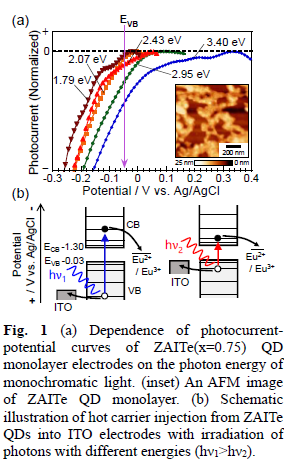

报告题目:Non-linear Photocatalytic Properties of Near-IR-Responsive Multinary Quantum Dots
报告时间:2021年9月27日(星期一)上午10:00-11:30
报告地点:腾讯会议
会议ID: 568 7724 8100
报 告 人:Prof. Tsukasa Torimoto(教授、名古屋大学)
报告主持人:Prof. Masakazu Ampo(伟德bv1946官网&大阪府立大学)
报告摘要:
Semiconductor quantum dots (QDs) showing near-IR responsivity, such as CdSe, CdTe, and PbS, have attracted increasing attention as solar light-absorbing materials with practical applications. QDs have discrete energy levels in the conduction and valence bands. This feature induced unique photoresponses of QDs when they absorbed photons with energy higher than the Eg of QDs. For example, the relaxation times of hot carriers to band-edge states were considerably enlarged in QDs due to the phonon bottleneck effect, increasing the probability of hot carrier transfer before the release of excess kinetic energy as heat. Thus, the efficiencies of solar-light-driven photocatalysts are expected to be outstandingly high if photogenerated carriers are harvested from QDs without energy loss of incident photons. Here we introduce the preparation of near-IR-responsive Zn-Ag-In-Te (ZAITe) QDs, the energy structure of which is controllable with the chemical composition, and discuss their non-linear photoelectrochemical and photocatalytic properties arising from photogenerated hot carriers.(1,2)
Rod-shaped (AgIn)xZn2(1-x)Te2 (ZAITe) QDs were prepared by the reaction of corresponding metal acetates with trioctylphosphine telluride at 250 oC in dodecanethiol. Photoelectrochemical properties of ZAITe QDs immobilized on ITO electrodes were measured in an aqueous solution containing 0.20 mol dm-3 Eu(NO3)3 (pH 2.3) as an electron acceptor under an N2 atmosphere. ZAITe QDs immobilized on an ITO electrode with a thickness of less than one monolayer exhibited the p-type semiconductor photoresponse, which was remarkably different from that of ZAITe QD multilayer films.(1) The onset of a cathodic photocurrent was shifted more positively than that of the valence band maximum (EVB) of ZAITe QDs due to hot hole transfer, the degree being enhanced with an increase of irradiated photon energy (Fig. 1). On the other hand, hot electron transfer occurred when methyl viologen (MV2+) was strongly adsorbed on QDs. Transient spectroscopy revealed that the bleaching of the exciton peak in ZAITe QD-MV2+ complexes was evolved faster than that of ZAITe QDs. The hot electron transfer efficiency increased from 45% to 72% with increasing excitation photon energy.(2)
In conclusion, we found that multinary QDs also exhibited efficient hot carrier transfers, being similar to binary QDs, such as PbS and CdSe. Tunable oxidation and reduction powers of hot carriers, depending on the irradiation photon energy, will enable to develop novel reactions with QD photocatalysts operating with quantum effects.
[1] T. Torimoto, et al., ChemNanoMat, 2019, 5, 1028-1035. [2] T. Torimoto, et al., RSC Adv., 2020, 10, 16361-16365.

报告人简介:
Tsukasa Torimoto教授自2005起就职于日本名古屋大学(Nagoya University)。
获奖情况:
2017 日本电化学协会科学成就奖
2016 日本光化学协会奖
2001 日本电化学协会青年研究员奖